Find current and past issues on JSTOR, or for more information on the publication or how to subscribe, check out our website.
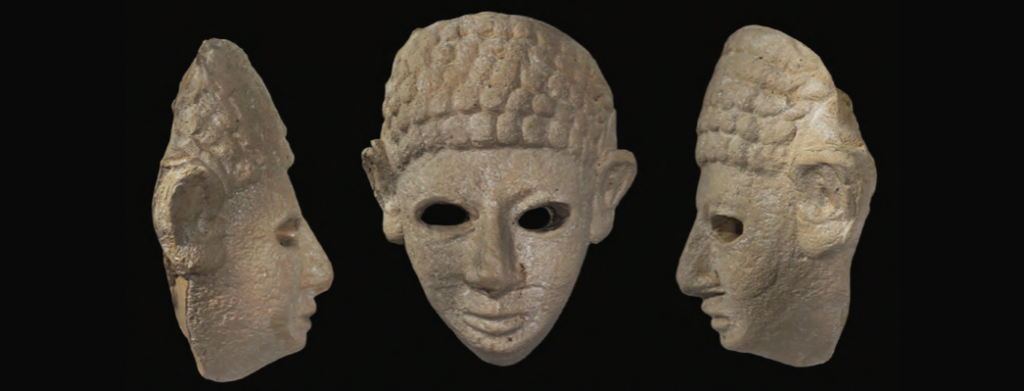
Near Eastern Archaeology Vol. 79, No. 4, Decemberarticle, “A Rare Discovery at Tel Achziv: A Phoenician Clay Mask Mold from the Ninth Century B.C.E.,” by Michael Jasmin (CNRS laboratory), Yifat Thareani (EPHE), and Philippe Abrahami (University of Lumière Lyon 2).
Renewed excavations on the tell of Achziv in the north of Israel by a French-Israeli team have led to the discovery (in July) of a very rare find: a clay anthropomorphic mask mold. Read more …
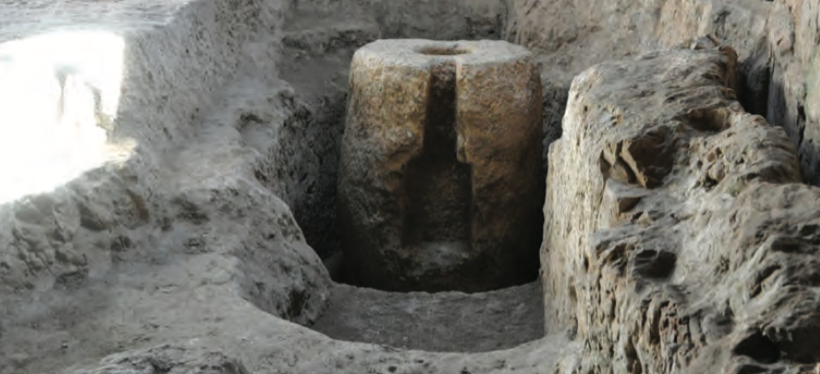
The oil press, showing two cross-shaped press frames in the eastern wall.
Near Eastern Archaeology Vol. 79, No. 4, Decemberarticle, “A Clay Bread Stamp from Khirbet et-Tireh,” by Salah H. Al-Houdalieh (Al-Quds University).
The clay bread stamp presented here was found at in a monastic complex dating to the Late Byzantine-Early Islamic period at Khirbet et-Tireh, approximately 16 km northwest of Jerusalem. The stamp, which consists of a cross and other simple geometrics, is of fired clay and is notable both for its workmanship and for surviving almost completely intact. Read more …

Near Eastern Archaeology Vol. 79, No. 4, Decemberarticle, “You Have Entered Joppa”: 3D Modeling of Jaffa’s New Kingdom Egyptian Gate,” by Jeremy I. Williams (University of California) and Aaron A. Burke (University of California).
Fromto, the Jaffa Cultural Heritage Project excavated several phases of an Egyptian New Kingdom gate complex located in Jaffa, Israel. Excavations inrevealed extensive remains of the Level IVB/Phase RG-4a gate, which was destroyed in a major conflagration ca. Read more …
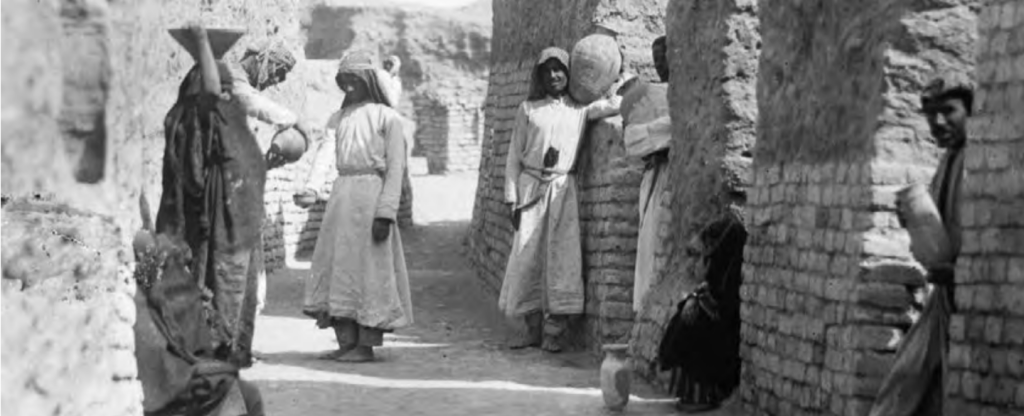
Woolley’s workers at Ur. Photograph reproduced courtesy of the British Museum.
Near Eastern Archaeology Vol. 79, No. 4, Decemberarticle, “Archaeology Returns to Ur: A New Dialog with Old Houses,” by Elizabeth C. Stone (Stony Brook University) and Paul Zimansky (Stony Brook University).
More than eighty years after Woolley’s departure, the authors have initiated excavations in Mesopotamia’s most celebrated residential district, Ur’s Area AH. Did private housing change significantly as Ur went from the capital of a bureaucratic empire under its Third Dynasty to a city-state in the Isin-Larsa period? Read more …

Radiocarbon calibration curve (INTCAL13) for the eleventh–ninth centuries
BCE.
Near Eastern Archaeology Vol. 79, No. 4, December article, “Archaeomagnetism, Radiocarbon Dating, and the Problem of Circular Reasoning in Chronological Debates: A Reply to Stillinger et al.,” by Katharina Streit (Hebrew University of Jerusalem) and Felix Höflmayer (Institute for Oriental and European Archaeology of the Austrian Academy of Sciences).
In the Juneissue of Near Eastern Archaeology, Michele D. Stillinger, James W. Hardin, Joshua M. Feinberg, and Jeffrey A. Blakely published a paper entitled “Archaeomagnetism as a Complementary Dating Technique to Address the Iron Age Chronology Debate in the Levant” (Stillinger et al.) in which the authors argue that archaeomagnetism “can provide a complementary dating tool to build a stronger, more robust chronology for the Iron Age” (90).

By monitoring a wide range of social media, ASOR’s Syrian Heritage Initiative seeks to identify and document destruction as it occurs in real time with a view to developing plans to restore Syria and Iraq’s cultural heritage. Image from the Syrian Heritage Initiative Weekly Report 18.
Near Eastern Archaeology, Vol. 79, No. 4 (December) article, “Stepping It Up (Like a Ziggurat): Education, ASOR, and the Twenty-First Century,” by Susan E. Alcock. Alcock serves as special counsel for institutional outreach and engagement and is professor of classical archaeology and classics at the University of Michigan.
The special burden ASOR bears, namely, the fact that its core geographical focus is notoriously in the news, gives its members an especial opportunity and incentive to be vocal on the topic of heritage loss.
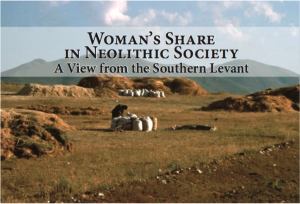
Woman doing agricultural work in rural Turkey. Photograph by Jane Peterson. (Near Eastern Archaeology, Vol. 79, Issue 3, September)
Near Eastern Archaeology 79:3 article, “Woman’s Share in Neolithic Society: A View from the Southern Levant,” by Jane Peterson, Professor of Anthropology in the Department of Social and Cultural Sciences at Marquette University.
Early farming groups set into motion substantial, even revolutionary, socioeconomic changes during the Pre-Pottery Neolithic period (ca. 10,500– 6,000 cal. b.c.e.) in the southern Levant of South- west Asia. Social organizational structures capable of addressing new opportunities and challenges would have been integral to these developments.
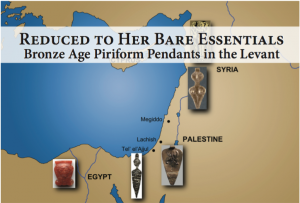
Map of Eastern Mediterranean, with sites referenced in the text. Courtesy of Paul C. Butler.
Near Eastern Archaeology 79:3 article, “Reduced to Her Bare Essentials: Bronze Age Piriform Pendants in the Levant,” by Stephanie L. Budin, ancient historian who focuses on ancient Greece and the Near East.
This article considers the symbolic meanings of the face, breasts, vulva, and branch images which typify the schematic piriform pendants which first emerged in Tell el-‘Ajjul in the Late Bronze Age and spread through the Levant. In contrast to the usual hypotheses regarding fertility, Budin suggests that each of these elements refer to the Egyptian goddess Hathor as aspects of her attributes and powers in the Levant under Egyptian domination.

Woman doing agricultural work in rural Turkey. Photograph by Jane Peterson. (Near Eastern Archaeology, Vol. 79, Issue 3, September)
Near Eastern Archaeology 79:3 article, “Woman’s Share in Neolithic Society: A View from the Southern Levant,” by Jane Peterson, Professor of Anthropology in the Department of Social and Cultural Sciences at Marquette University.
Early farming groups set into motion substantial, even revolutionary, socioeconomic changes during the Pre-Pottery Neolithic period (ca. 10,500– 6,000 cal. b.c.e.) in the southern Levant of South- west Asia. Social organizational structures capable of addressing new opportunities and challenges would have been integral to these developments. This contribution focuses on the archaeological evidence from which our understanding of the gendered aspects of this new social order can be gleaned. Specifically, evidence for sex-based labor patterns, the relative status of men and women, and gendered ideology are discussed by synthesizing current data from human skeletal remains, mortuary contexts, architecture, and figurative art. Available evidence does not support the hypothesis that Pre-Pottery Neolithic societies were organized hierarchically in terms of gender.
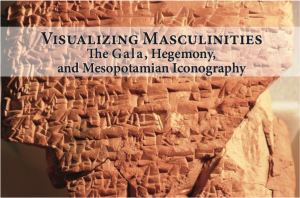
A fragment of the Old Babylonian “Lament for Eridu,” a typical composition that belonged to the corpus of lamentations uttered by the g a l a /kalû. Tablet CBS 2189+2227+2297a, excavated in Nippur (modern Nuffar), currently stored in the Babylonian Section of the University of Pennsylvania Museum of Archaeology and Anthropology. Photograph taken by Ilan Peled. Published with the kind permission of the collection curators, Professors Grant Frame and Steve Tinney.
Near Eastern Archaeology 79:3 article, “Visualizing Masculinities: The Gala, Hegemony, and Mesopotamian Iconography,” by Ilan Peled, Visiting Scholar at the Leiden University Institute for Area Studies.
This article examines the gender image of the Mesopotamian cult attendant known as gala (Sumerian) / kalû (Akkadian) against the background of the theory of hegemonic masculinity, putting an emphasis on visual representations as sources of information. The gala/kalû was a performer in funerals and later a professional lamenter in the cult of Inanna/Ištar. His gender identity has long been considered to have possessed ambiguous elements: effeminate, homoerotic, and the like. A more nuanced approach is offered here, whereby the gala/kalû’s gender image is analyzed as a social construct of a non-hegemonic type of masculinity. To this end, visual representations are considered in addition to textual evidence.
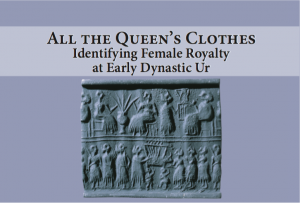
Cylinder seal impression from grave PG 1237 in the Ur Royal Cemetery showing seated banquet scene. Courtesy of the University of Pennsylvania Museum of Archaeology and Anthropology.
Near Eastern Archaeology 79:3 article, “All the Queen’s Clothes: Identifying Female Royalty at Early Dynastic Ur,” by Aubrey Baadsgaard, consultant scholar in the Near East Section of the University of Pennsylvania Museum of Archaeology and Anthropology and an Adjunct Assistant Professor in the Department of Anthropology at Gettysburg College.
In spite of widespread recognition of the burial of high-ranking individuals, including women, in the Early Dynastic Ur Royal Cemetery, ca. 2500 B.C.E., most of the details about the nature of their social position remain obscure. This article attempts to fill this gap by identifying the possible social roles of prominent females buried in the cemetery. A reconsideration of the evidence from three royal graves reveals how high-ranking females might have attained social and political prominence and asserted profound social influence, ultimately perhaps wielding power and prestige in their own right and acting as full participants in the building and institutionalization of increasingly complex social roles and institutions in Early Dynastic Mesopotamian society.
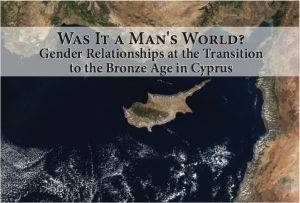
Cyprus and the eastern Mediterranean satellite image. Source: NASA, The Visible Earth
Near Eastern Archaeology 79:3 article, “Was It a Man’s World? Gender Relationships at the Transition to the Bronze Age in Cyprus,” by University of Cyprus Department of History and Archaeology research associate and Hellenic Open University adjunct lecturer, Maria Mina.
This article examines whether the apparently equitable gender relationships of the Chalcolithic period in Cyprus were replaced by gender inequality in the Bronze Age. The discussion critiques the axioms (assumptions, really) that underlie the idea that technological advancement brings gender inequality while considering some of the data for gender relations in Early Bronze Age Cyprus.